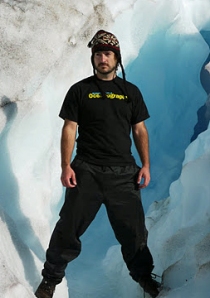New clues as to how the Earth’s remote ecosystems have been influenced by the industrial revolution are locked, frozen in the ice of glaciers. That is the finding of a group of scientists, including Aron Stubbins of the Skidaway Institute of Oceanography.
 The research is published in the March 2012 issue of Nature Geoscience.
The research is published in the March 2012 issue of Nature Geoscience.
The key to the process is carbon-containing dissolved organic matter (DOM) in the glacial ice. Glaciers provide a great deal of carbon to downstream ecosystems. Many scientists believe the source of this carbon is the ancient forests and peatlands overrun by the glaciers. However, Stubbins and his colleagues believe the carbon comes mainly from contemporary biomass and fossil fuel burning that gets deposited on the glacier surfaces. Once deposited on the glacier surface by snow and rain, the DOM moves with the glacier and is eventually delivered downstream where it provides food for microorganisms at the base of the marine food web.
“In vibrant ecosystems like in the temperate or tropical zones, once this atmospheric organic material makes landfall it is quickly consumed by the plants, animals and microbial populations,” said Stubbins. “However in frigid glacier environments, these carbon signals are preserved and standout.”
“Remote regions are often perceived as being pristine and devoid of human influence”, Stubbins continued. “Glaciers show us that nowhere goes untouched by industry. Instead, burning fuels has an impact upon the natural functioning of ecosystems far removed from industrial activity.”
Glaciers and ice sheets together represent the second largest reservoir of water on earth, and glacier ecosystems cover ten percent of the Earth, yet the carbon dynamics underpinning those ecosystems remain poorly understood.
“Increased understanding of glacier biogeochemistry is a priority, as glacier environments are among the most sensitive to climate warming and the effects of industrial emissions” said Stubbins.
Globally, glacier ice loss is accelerating, driven in part by the deposition of carbon in the form of soot or “black carbon”, which darkens glacier surfaces and increases their absorption of light and heat. Biomass and fossil fuel burning by people around the globe are the major sources of that black carbon.
Stubbins and his fellow scientists have conducted much of their research at the Mendenhall Glacier near Juneau, Alaska. Mendenhall and other glaciers that end their journey in the Gulf of Alaska receive a high rate of precipitation. High levels of rain and snow acts to strip the atmosphere clean of organics, dumping it on the glacier. Consequently, these glaciers are among the most sensitive to global emissions of soot.
The researchers’ findings also reveal how the ocean may have changed over past centuries. The microbes that form the very bottom of the food web are particularly sensitive to changes in the quantity and quality of the carbon entering the marine system. Since the study found that the organic matter in glacier outflows stems largely from human activities, it means that the supply of glacier carbon to the coastal waters of the Gulf of Alaska is a modern, post-industrial phenomenon. “When we look at the marine food webs today, we may be seeing a picture that is significantly different from what existed before the late-18th century,” said Stubbins. “It is unknown how this manmade carbon has influenced the coastal food webs of Alaska and the fisheries they support.”
A warming climate will increase the outflow of the glaciers and the accompanying input of dissolved organic material into the coastal ocean. This will be most keenly felt in glacially dominated coastal regions, such as those off of the Gulf of Alaska, Greenland and Patagonia. These are the areas that are experiencing the highest levels of glacier ice loss.
“Although it is not known to what extent organic material deposition has changed and will continue to alter glacially-dominated coastal ecosystems or the open ocean, it is clear that glaciers will continue to provide a valuable and unique window into the role that the deposition of organic material plays in our changing environment,” Stubbins said.
Stubbins collaborators on the project included Eran Hood and Andrew Vermilyea from the University of Alaska Southeast; Peter Raymond and David Butman from Yale University; George Aiken, Robert Striegl and Paul Schuster from the U.S. Geological Survey; Patrick Hatcher, Rachel Sleighter and Hussain Abdulla from Old Dominion University; Peter Hernes from the University of California-Davis; Durelle Scott from Virginia Polytechnic Institute and State University; and Robert Spencer from Woods Hole Research Center.
The paper can be viewed on-line at http://dx.doi.org/10.1038/NGEO1403
Further details are available at https://www.skio.usg.edu/?p=research/chem/biogeochem/glaciers. This work is being continued with support from the National Science Foundation: http://www.nsf.gov/awardsearch/showAward.do?AwardNumber=1146161
The Skidaway Institute of Oceanography is an autonomous research unit of the University System of Georgia located on Skidaway Island in Savannah, Ga. The mission of the Institute is to provide the State of Georgia with a nationally and internationally recognized center of excellence in marine science through research and education.




Good post however I was wanting to know if you could write a litte
more on this subject? I’d be very grateful if you could elaborate a little bit more.
Kudos!